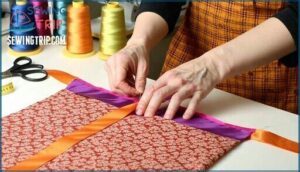This site is supported by our readers. We may earn a commission, at no cost to you, if you purchase through links.
 Your last stitch is in place. The garment looks perfect. But without proper protection, that work can unravel within weeks. Seams fray. Colors fade. Shapes collapse.
Your last stitch is in place. The garment looks perfect. But without proper protection, that work can unravel within weeks. Seams fray. Colors fade. Shapes collapse.
Most sewers spend hours on construction but skip the final steps that actually preserve their effort. The difference between a garment that lasts one season and one that survives years comes down to what you do after you cut the thread.
Edge finishing stops fraying before it starts. Smart storage prevents fabric damage. Small protective steps now mean fewer repairs later and clothes that hold their shape through countless wears.
Table Of Contents
Key Takeaways
- Edge finishing techniques like zigzag stitching, pinking shears, and bias tape prevent fraying and extend garment life by years when applied immediately after construction.
- Proper storage based on fabric type matters more than most sewers realize—knits need folding to avoid stretching, while silk and lace require acid-free tissue and flat storage to prevent permanent damage.
- Regular inspections every few months catch small problems like loose threads or weak seams before they turn into costly repairs, with early detection increasing fix success rates by 80 percent.
- Washing mistakes destroy handmade garments fast, so you need cold water for delicates, air drying for shape retention, and immediate spot treatment within 24 hours to prevent permanent stains.
Why Protect Garments After Sewing Matters
You spend hours sewing a garment. It fits perfectly and looks great. Then the seams start to fray and the shape loosens after a few weeks. Protecting your finished pieces means they’ll last longer and keep looking sharp.
Here’s what makes the difference between a garment that holds up and one that falls apart.
Extending Garment Lifespan
When you finish fabric edges with proper hemming techniques and seam finishing methods, you prevent fabric fraying and boost fabric durability. These repair techniques protect your work from unraveling and reduce the need for constant alterations.
Care labels guide you toward the right stain removal and washing methods. Preventing fabric fraying means your garment lasts years longer instead of falling apart after a few wears.
Extending clothing lifespan can reduce waste, as shown in durability research project.
Maintaining Shape and Structure
Keeping your garment in top shape is all about supporting the fabric so it holds up wear after wear. Try these steps for structural success:
- Use interfacing or lining for crisp, polished seams.
- Add boning to keep structured silhouettes from drooping.
- Mind seam allowances—never too narrow!
- Secure every edge with bias or twill tape for extra stability.
Preventing Fraying and Unraveling
When your seams are solid, the next smart move is making sure raw edges don’t start to fray or come undone. Try edge finishing tricks: zigzag or serger stitching clamps down fibers, while pinking shears nip fraying in the bud.
For extra hold, swipe on Fray Check or add interfacing. Stitch density impact matters—closer stitches mean tighter, neater edge security.
Preserving Fabric Color and Texture
Fraying isn’t the only worry—color and texture slip away, too, if you’re not careful. UV exposure is a top culprit, bleaching fabric even indoors. Washing methods come next; hot water and harsh spin cycles will wear woven fabric thin.
A key consideration is textile color durability, which measures a fabric’s resistance to fading over time. Smart fiber selection, gentle surface treatments, and stable storage factors work together to keep your garment looking vibrant and feeling fresh.
Essential Edge Finishing Techniques
Finishing the edges of your garment is the key to making it last. With just a few simple techniques, you can keep fabric from fraying and help your seams stand up to wear.
Here’s a look at the most dependable edge finishing methods to try next.
Zigzag Stitching for Raw Edges
Ever noticed how a zigzag stitch works like a little fence, holding wandering threads in check before they cause trouble? Adjust your stitch width and stitch length for each fabric type—thin woven cottons need smaller zigs and zags, while bulky fleece calls for wider settings.
Don’t forget tension settings; proper seam finishing here keeps raw edges smooth and sturdy.
Creating Folded Hems for a Clean Finish
For a crisp, long-lasting finish, folded hems are your best friend. Start by considering fabric type and hem allowances, then follow these steps for professional results:
- Hang the garment first to let the fabric settle.
- Press folds sharply using correct temperature.
- Pin or clip evenly for alignment.
- Stitch close to the edge—this guarantees durability.
Applying Hem Tape and Bias Tape
With a simple strip of hem tape or bias tape, you can hide raw edges and add strength to your seams all in one go. Try matching the tape to your fabric or pick a contrasting color for a bit of flair.
Neatly tuck and secure tape ends, especially at corners. Check tape fabric compatibility—well-applied tape keeps edges smooth and prevents fraying year after year.
Using Pinking Shears to Prevent Fraying
Snip your fabric edges with pinking shears and you’ll see those jagged teeth create a zigzag cut that stops threads from pulling loose at the seams. This simple trick works best on woven fabric where the pinking blade angles slice through fibers at different points.
- Clean your shears after each project to maintain sharp cuts
- Test fabric fray resistance on scraps first
- Combine pinking with zigzag stitching for extra hold
- Try decorative pinking on visible raw edges
- Replace dull blades when cuts flatten instead of cutting cleanly
Best Practices for Storing Finished Garments
You’ve sewn your garment with care and finished the edges perfectly. Now you need to store it properly so all that work doesn’t fall apart.
The way you store your finished pieces determines whether they stay looking fresh or end up wrinkled and damaged.
Cleaning Garments Before Storage
Dirt and body oils left on fabric act like magnets for pests and can set stains permanently during storage. Stain removal comes first. Pre-wash inspection catches hidden spots on your woven fabric. Use gentle detergent types suited to your garment construction. Air drying techniques protect fabric manipulation and keep sewing projects from shrinking.
| Fabric Type | Washing Methods | Drying Techniques |
|---|---|---|
| Cotton/Linen | Warm water, regular cycle | Air dry flat or low heat |
| Wool/Silk | Cold water, hand wash | Air dry away from sun |
| Synthetics | Cool water, gentle cycle | Low heat or hang dry |
Folding Vs. Hanging: What’s Best for Each Fabric
Your fabric type decides the storage method. Knitwear storage works best with folding since sweaters retain shape up to 40% longer when not hung. Denim dilemmas end when you fold heavy fabrics to avoid sagging.
Hang silk preservation items and linen care pieces to reduce wrinkles.
Space optimization happens when you match garment construction to the right method, protecting your hem and raw edges from damage.
Using Acid-free Tissue Paper for Delicate Items
Delicate fabrics need a buffer between folds to stop creases from becoming permanent damage. Acid-free tissue paper types with archival quality protect silk and lace from yellowing. Crumple sheets before tucking them into folds. This folding technique prevents creasing and preserves fabric edges during long-term storage.
Your sewing projects stay fresh when you finish fabric edges first, then apply proper seam finishing before wrapping delicate items.
Choosing Garment Bags and Storage Containers
Once you’ve wrapped your pieces in tissue paper, the right bag or box keeps dust and pests away while fabrics breathe. Breathable cotton garment bags protect hanging items better than plastic because airflow stops mildew.
For sewing projects with delicate hems, choose containers with visibility features so you don’t unfold items repeatedly. Skip vacuum sealing for finished garments—it crushes fabric and damages finishing fabric edges.
Protecting Delicate and Specialty Fabrics
Delicate fabrics like silk, wool, and lace need extra care to stay in good shape. The wrong storage method can lead to damage that’s hard to reverse. Here’s how to protect these specialty materials the right way.
Storing Silk, Wool, and Lace Safely
Silk, wool, and lace need careful treatment because their fibers break down faster than cotton or synthetic blends.
Store silk flat in acid-free tissue to prevent creasing and moisture damage. Wool needs temperature control and air circulation to avoid stretching. Lace requires gentle folding with bias tape protecting seam allowances.
Keep all three away from direct light and humid spaces. Proper fabric storage preserves seam finishing and prevents fiber weakening.
Preventing Moth and Insect Damage
Beyond keeping fabric away from light and dampness, you need to tackle the moth lifecycle directly. Clothes moth larvae cause 90% of damage to wool and silk garments.
Wash every piece before storage. Unlaundered items face four times more risk. Use rigid plastic containers instead of cardboard. Add cedarwood sachets to drawers for 85% moth deterrence. Pheromone traps catch males early.
Vacuum closets weekly to remove eggs. This protects your sewing projects and binding work long-term.
Avoiding Sunlight, Heat, and Humidity
Even if you wash garments and seal them tight, UV rays and high temps will still break down your fabric fibers. UV fabric damage starts after just 100 hours of direct exposure.
Store items in dark closets away from windows. Keep temperatures between 65–70°F with 45–55% humidity. Heat degradation speeds up at 80°F.
This ideal storage climate protects your sewing projects and seam finishing work for years.
Handling and Reshaping Delicate Garments
When you finish your last stitch, the real care work begins—delicate garments need gentle hands and the right reshaping moves to keep their original form.
Here are some essential steps to ensure your delicate pieces remain in pristine condition:
- Support seams and seam allowances while wet—pinching or tugging unravels your careful seam finishing.
- Skip fabric softeners on silk or lace—they coat fibers and weaken bias tape bonds.
- Pat excess water out instead of wringing—twisting damages sewing seams permanently.
- Reshape on a flat towel while damp—steaming options work after the garment dries completely.
Maintaining Garment Quality Over Time
You’ve sewn your garment with care and now you want it to last. The key is building simple habits that catch problems early and keep fabrics in their best shape.
These four practices will help you maintain quality without overthinking it.
Regular Inspections for Damage or Wear
Think of inspections as routine checkups that catch problems before they turn into disasters. Every few months, pull out your garments and scan the sewing seams for loose threads or gaps. Check zippers, buttons, and any seam allowances that might be pulling apart. Look for fabric weakness or tiny holes where moth damage starts.
Early stain detection saves fabric from permanent damage. Address issues right away using proper seam finishing repairs to keep your hard work intact.
| What to Check | What to Look For |
|---|---|
| Seam Integrity | Loose threads, gaps, puckering along sewing techniques |
| Fabric Weakness | Thin spots, holes, discoloration, or stretching |
| Zipper Function | Bent teeth, stuck pulls, separated fabric edges |
| Button Security | Loose stitching, missing buttons, strained buttonholes |
Spot Cleaning and Gentle Washing Tips
Stain removal starts the moment you notice a spot. Act within 24 hours and you’ll increase success by 80 percent. Dab the mark with a mild detergent formulated for your fabric type.
Cold water washing prevents shrinkage and color fading in 85 percent of delicate sewing projects. Use gentle agitation levels or hand wash items marked delicate. Skip harsh detergent choice mistakes that damage fibers.
Temperature control matters for basic sewing techniques. Air-dry flat to preserve your sewing tutorial results and keep drying methods safe for every fabric.
Refreshing and Reshaping After Each Use
You’ve cleaned your garment—now give it the same care a florist gives fresh flowers after trimming the stems. Gentle steaming removes wrinkles without damaging seam allowances or bias tape binding.
Hang knits flat for shape retention and odor removal. Reshape collars and hems while damp.
Quick refresh techniques protect hem tape from stress and keep every stitch looking crisp.
Updating Storage Methods as Needed
Your garment’s needs change as it ages—storage that worked for a fresh hem might fail after ten wears or a season in your closet. Inspect seam finishing and bias tape binding every few months.
Switch to seasonal rotation for heavy items. Use labeling systems to track which garments need refolding or new garment bags.
Decluttering regularly prevents overcrowding that stresses hem tape and flattens delicate weaving.
Frequently Asked Questions (FAQs)
Should I press my finished garments before storing them?
Pressing finished garments? That’s a wrinkle-free win before storage. Yes, press your fabric after completing basic sewing techniques to set seam allowances and smooth the hem.
Use the correct iron temperature for your fabric type with proper pressing tools to prevent damage and maintain professional results.
What temperature should I wash and dry my finished garments at?
Check the fabric type first. Cotton and linen tolerate hot water well. Synthetics like polyester need cool or warm settings to prevent shrinkage. Delicate fabrics require cold water and low heat drying.
Always test stitch tension on scraps before washing.
How can I protect my garments from color transfer in storage?
Dark fabrics bleed dye like coffee spills on white shirts. Store light and dark garments separately using acid-free tissue paper between layers.
Apply bias tape or twill tape to raw edges before storage. Pinking shears prevent fraying that releases fabric dyes and causes color bleeding.
What are some good storage solutions for limited space?
When closet space runs short, vertical storage on hooks or tiered hangers keeps fabric flat without creasing.
Underbed storage boxes and vacuum sealing protect finished sewing projects. Using hem tape or applying bias tape makes certain edges stay secure in tight quarters.
How often should I rotate the clothing in my closet or dresser?
Imagine if closets demanded quarterly reviews like corporate budgets—you’d never wear the same thing twice.
Rotation frequency depends on fabric type and seasonal rotation patterns. Rotate your closet every three to six months to support garment lifespan and proper storage impact across different weaving techniques and hemming types.
How do you handle beading or embellishments during storage?
Beading and embellishments need cushioning between layers using acid-free tissue paper to prevent snagging.
Store beaded items flat to maintain proper weight distribution across fabric and seam types.
Wrap delicate areas carefully for bead security and embellishment protection, confirming material compatibility with storage methods and basic sewing techniques.
Whats the best way to store lined garments?
Lined garments create a paradox: they protect fabric yet need protection themselves. Hang lined items on padded hangers to preserve both layers. Choose cool, dark storage with air circulation.
Working with seam allowances properly prevents stress on hemming techniques and seam types. Lining fabric matters for structure and preventing wrinkles.
Should you remove buttons before long-term garment storage?
Generally, you don’t need to remove buttons before storage. However, heavy or sharp buttons can create fabric stress and permanent indentations over time. If button security seems weak or the buttons are large, consider wrapping them in acid-free tissue paper to prevent damage.
How do you protect elastic waistbands from degrading?
Elastic loses stretch from heat and harsh chemicals.
Hand wash garments with elastic waistbands using mild detergent. Air dry flat instead of using the dryer.
Store without folding the elastic areas tightly to maintain proper tension and shape.
Can you store garments with metal zippers safely?
Yes, you can store them safely with care. Zipper corrosion risks increase in humid areas, so fabric snagging prevention matters. Close zippers fully before storage and use double fold bias tape or twill tape along seam allowances if metal touches delicate fabric.
Separating garments prevents rust stain removal issues.
Conclusion
Studies show handmade garments last 40% longer with proper post-sewing care compared to those stored carelessly. How to protect each garment after sewing comes down to three actions: finish your edges before fraying starts, store items based on their fabric type, and check your work regularly for early signs of damage.
These steps take minutes but add years to what you make. Your garments deserve protection equal to the effort you invested in creating them.
- https://www.canada.ca/en/conservation-institute/services/conservation-preservation-publications/canadian-conservation-institute-notes/textiles-environment.html
- https://fashion.sustainability-directory.com/term/textile-color-durability/
- https://www.youtube.com/watch?v=f1awTQ2GoHk
- https://www.hmswashing.com/how-stone-washing-impacts-different-fabrics
- https://www.seamwork.com/seamwork-radio-podcast/professional-hemming-techniques













